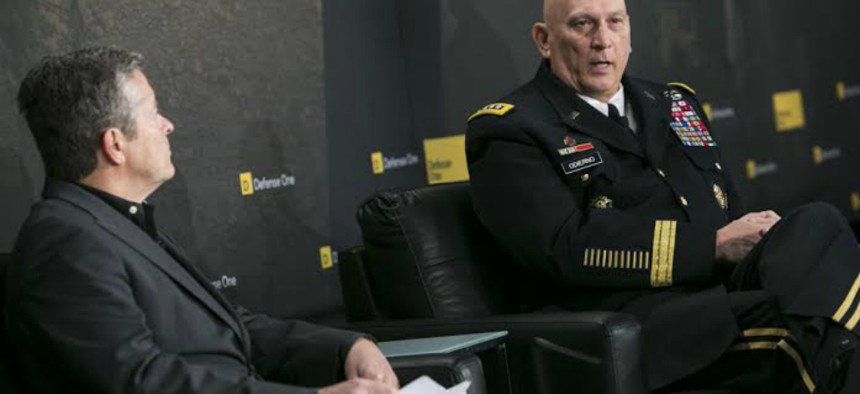
Army Chief of Staff Gen. Ray Odierno speaks at the Defense One Summit, with NPR's Tom Bowman, on Wednesday. Kristoffer Tripplaar
Odierno: I Need More Money and Troops for Today's Threats
Budget cuts are having serious effects in a world of vastly different threats than those lawmakers faced down three years ago. By Ben Watson
Army Chief of Staff Gen. Ray Odierno is prepared to make his case to Congress that the constraints of sequestration reflect a completely different world than the one Pentagon planners see today and into the future.
There were 510,000 active duty soldiers under the four-star general’s watch as recently as late September. But Odierno could see those numbers decline to levels not seen since 1940 if Congress keeps the 2011 Budget Control Act in place through 2016.
“When we developed the new defense strategy back in 2012, we all agreed to 490 [thousand] was the right strength to execute the defense strategy,” Odierno said Wednesday at the Defense One Summit in Washington, D.C. “We made assumptions that we wouldn’t be using Army forces in Europe the way we used to. We made assumptions that we wouldn’t go back into Iraq. We are back in Iraq. Here we are worried about Russia again. So I think we should be very careful and mindful of the decisions we’re making.”
Odierno said the U.S. has 1,500 soldiers in Iraq now, with “another 1,600 that will go within the next 30 to 45 days and we believe that’s something that will go on for quite some time—years, not months… So I think it’s time to have a real discussion about what we think we’re going to be doing over the next five or 10 years.”
The Army is looking at a force of around 440,000 active duty soldiers if sequestration continues, he said. “And depending on how much money is taken, we have no choice.”
(Related: A New Army Drawdown: This Time Is Far Worse)
And 20 percent of the Army’s force structure is devoted to staffing training schools and headquarters. “So take 100,000 right off the top… You have another 13 percent that’s always in school,” which he said removes an additional 65,000 troops from deploying at any given moment. And another 50,000 soldiers are committed to staffing combatant commands in regions like Africa and the Pacific theater. With the Army’s 40,000 special operations troops focused on their specific missions, Odierno said all of that ties the Army’s hands when it comes to responding to crises like what’s developed in Iraq or Eastern Europe.
“And so my worry is based on how I view the world—and I’ve talked a lot about the velocity of instability is increasing significantly—that I don’t see a downturn in requirements,” Odierno said. “So in my mind it’s about us talking with Congress and others about understanding the risks associated with it, and that they have to re-evaluate and review some of the decisions they’ve made.”
Odierno said he’s prepared to make the case for working beyond the current fiscal and associated manpower constraints of sequestration at the Pentagon’s posture hearings in March and April. “I said them last year actually; I will say them again this year,” he said.



